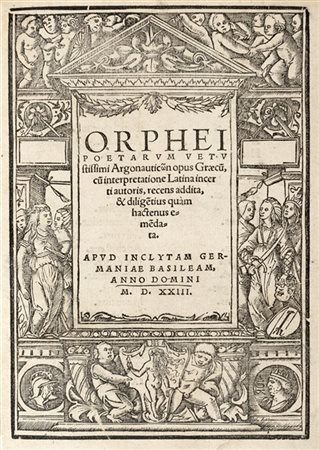 Il Ponte Casa d'Aste - Palazzo Crivelli - Via Pontaccio 12, 20121 Milano
Il Ponte Casa d'Aste - Palazzo Crivelli - Via Pontaccio 12, 20121 Milano
LIBRI E MANOSCRITTI I TORNATA : LIBRI E MANOSCRITTI
martedì 21 gennaio 2020 ore 15:00 (UTC +01:00)
LUCIANO DI SAMOSATA (120-192 d.C.) - De Veris Narrationibus commentarii duo. Ba
LUCIANO DI SAMOSATA (120-192 d.C.) - De Veris Narrationibus commentarii duo. Basilea: eredi di Valentino Curione, 1524 - [LEGATO DOPO:] ORFEO. Orphei poetarum vetustissimi Argonauticon opus graecum. Basilea: Andrea Cratandri, 1523.
La prima descrizione letteraria di un viaggio sulla luna nella prima edizione separata dell'opera in greco del celebre scrittore Luciano. Nella affascinante narrazione l'autore lascia lo stretto di Gibilterra in barca a vela con l'intenzione di attraversare l'Atlantico, ma viene colto da una tempesta che dura sette giorni e che lo porta ad atterrare direttamente sulla luna. Qui i viaggiatori assistono alla prima guerra interplanetaria mai combattuta che vede protagonisti i "Selenitai" (abitanti della luna) e gli "Heliotai" (abitanti del sole) per la colonizzazione della stella del mattino. Come in ogni racconto fantascientifico che si rispetti i combattenti sono creature aliene che precedono i moderni Flash Gordon e Star Treck. L'intenzione di Luciano fu fare una parodia degli storici e filosofi che scrivevano di luoghi e creature esotiche mai viste. Alcuni studiosi hanno messo in relazione il racconto di Luciano con le Mille e una notte e con altri celebri racconti quali quelli di Rabelais, Cervantes, Cyrano de Bergerac e Swift. Il "De Veris Narrationibus" era già apparso tre volte prima di questa edizione nelle Opere complete di Luciano stampate a Firenze nel 1496 e a Venezia nel 1503 e 1522. Questa edizione, la prima a essere pubblicata separata nel greco originale, è accompagnata da un anonima traduzione in latino fatta, come si legge al frontespizio, per assistere gli studenti che imparano il greco. L'opera di Orfeo legata insieme è anch'essa la prima pubblicazione del testo separato in greco."The earliest surviving interplanetary romance" (Locke, Voyages in Space, p. 11).
2 opere in un volume, 8vo (200 x 145mm). L'opera di Luciano con decorazioni xilografiche al frontespizio e quella di Orfeo con frontespizio entro elaborata cornice xilografica da Holbein; entrambi con testo in greco e latino, iniziali xilografiche decorate, grande marca tipografica in fine (alcune lievi macchie di umidità al margine inferiore e occasionali bruniture). Cartone marmorizzato del secolo XIX con dorso in pelle (un po' liso e sfregato).
-EN
LUCIANO DI SAMOSATA (120-192 d.C.) - De Veris Narrationibus commentarii duo. Basilea: eredi di Valentino Curione, 1524 - [LEGATO DOPO:] ORFEO. Orphei poetarum vetustissimi Argonauticon opus graecum. Basilea: Andrea Cratandri, 1523.
The First Account in Literature of a Trip to the Moon. First separate edition in the original Greek of the True Story, the first account in literature of a trip to the Moon, by the second-century A.D. Syrian-Greek satirist Lucian of Samosata. In this first-person narrative the author sets sail with a crew of fifty companions from the Straits of Gibraltar, intending to sail across the Atlantic, but is swept away by a storm for seven days and seven nights, eventually landing on the moon; there the travelers observe the first interplanetary war in literature, fought between the "Selenitai" (People of the Moon) and the "Heliotai" (People of the Sun) over colonization rights to the Morning Star. The combatants, in true science-fantasy fashion, consist of fanciful creatures that are the spiritual ancestors of those found in Flash Gordon, Star Wars, and Star Trek: "Hippogypoi" (Vulture-Knights), "Hippomyrmekoi" (Ant-Knights), "Skorodomachoi" (Garlic-Fighters), "Psyllotoxotai" (Flea-Archers), "Lachanopteroi" (The Vegetable-Winged), "Anemodromoi" (Wind-Gliders), "Nephelokentauroi" (Cloud-Centaurs), etc.Lucian's intent was to parody the poets, historians, and philosophers who wrote about fabulous places they had never visited and exotic creatures they had never seen. Some scholars have detected in Lucian's True Story influences of versions of the tales found in the Arabian Nights, which may have been current in Lucian's native Syria; indeed, some of the elements in the True Story, such as the 150-mile-long sea-monster that swallows Lucian's ship, and the giant kingfisher, have much in common with, respectively, the huge fish of the Seventh Voyage of Sindbad, and the Roc in the Second Voyage. Lucian's True Story exerted its own, long influence, directly or indirectly, on such storytellers as Rabelais, Cervantes, Cyrano de Bergerac, and Swift; a notorious direct borrower from Lucian's True Story was Rudolf Eric Raspe (1737-1794), whose tall tales based on Baron Munchausen (1785), included a narrative of Munchausen's visit to the moon.The True Story had appeared three times before in Greek as part of Lucian's complete works: Florence 1496, Venice 1503 and 1522. The present edition, the earliest separately printed in the original Greek, is accompanied by an anonymous literal Latin translation intended (as stated in the title) "to assist students in learning Greek without great effort and without a teacher"."
Orpheus' work is the first separate edition of the Greek text.
2 works in one volume, 8vo (200 x 145mm). Luciano's work with woodcut decorations on title, Orpheus' with title within woodcut border by Holbein; both with text in Greek and Latin, woodcut decorated initials and large printer's device at end (some light waterstaining to bottom margin and occasional browning). 19th-century marbled boards backed in sheep (extremities rubbed and corners bumped). VD 16, L 3056; Hoffmann II, 547 e III, 31; Hieronymus, Griechischer Geist aus Basler Pressen, 33 e 157; not in BL, not in Adams; see Locke, Voyages in Space, p. 11 ("The earliest surviving interplanetary romance").


